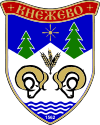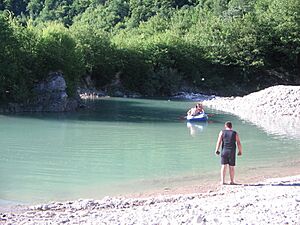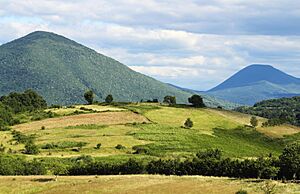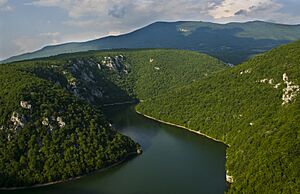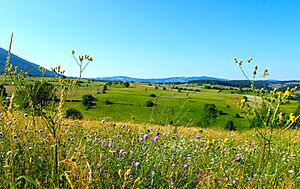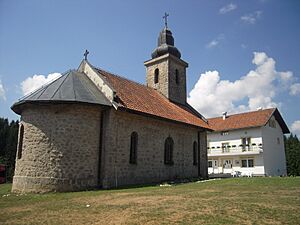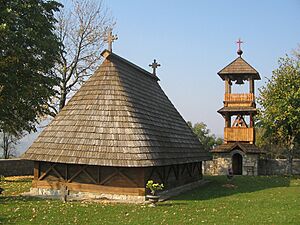Kneževo, Bosnia and Herzegovina facts for kids
Quick facts for kids
Kneževo
Кнежево
|
||
|---|---|---|
|
Town and municipality
|
||
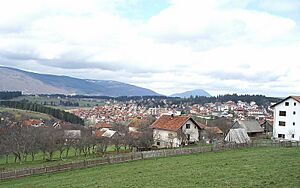
Kneževo
|
||
|
||
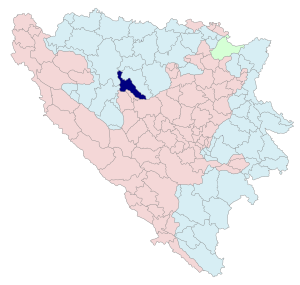
Location within Bosnia and Herzegovina
|
||
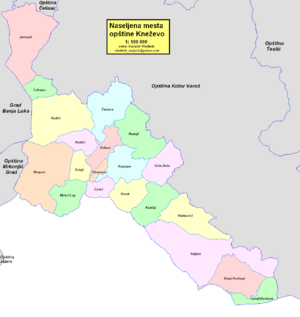 |
||
| Country | ||
| Entity | ||
| Area | ||
| • Total | 332.9 km2 (128.5 sq mi) | |
| Population
(2013 census)
|
||
| • Total | 9,793 | |
| • Density | 29.417/km2 (76.190/sq mi) | |
| Time zone | UTC+1 (CET) | |
| • Summer (DST) | UTC+2 (CEST) | |
| Area code(s) | 51 | |
| Website | Official Kneževo Municipality Website: https://web.archive.org/web/20150714171428/http://www.opstinaknezevo.com// | |
Kneževo (Serbian Cyrillic: Кнежево), also known as Skender Vakuf (Serbian Cyrillic: Скендер Вакуф), is a town and a municipality in Republika Srpska, Bosnia and Herzegovina. In 2013, about 9,793 people lived there.
Contents
The Name of Kneževo
Before the Bosnian War (1992-1995), the town was called Skender Vakuf. During the war, the authorities in Republika Srpska changed its name to Kneževo. Because of this, some news and media in the area still call it Skender Vakuf-Kneževo.
A Look at Kneževo's History

Long ago, during the time of the Roman Empire, a Roman basilica (a type of large public building) was found in nearby Imljani and Javorani. Parts of an old Roman road, which connected Servitium (today's Banja Luka) to Levsaba (Travnik), were also discovered close by.
You can also find old tombstones called Stećaks in the area. These date back to the 14th and 15th centuries, when this region was part of the Kingdom of Bosnia.
The town of Kneževo was founded during the rule of the Ottoman Empire. It was first mentioned in official records in 1693. The town's original name, Skender Vakuf, comes from a charitable gift (called a vakuf) made by Ali-dedo Skender, which helped the town grow.
Sadly, the Old Mosque and the New Mosque in Skender Vakuf were destroyed in 1992 during the Bosnian War. A very sad event also happened in 1992, known as the Korićani Cliffs massacre. During this event, many Bosniak and Croat people were killed in the municipality. After the war, a part of the municipality became a new area called Dobretići.
Exploring Kneževo's Geography
Kneževo is located between three rivers: the Ugar, the Vrbas, and the Vrbanja. It is surrounded by mountains like Čemernica and Ranča to the west, Vlašić to the south, and Ježica to the northeast.
The town itself is about 864 meters (2,835 feet) above sea level. However, the land in the municipality ranges from 600 meters (1,969 feet) to 1,493 meters (4,898 feet) high. Kneževo is about 50 kilometers (31 miles) southeast of Banja Luka, which you can reach by the M56 motorway.
Kneževo shares borders with several other municipalities. These include Čelinac to the far north, Kotor Varoš to the east, and Travnik, Dobretići, and Jajce to the south. To the west is Mrkonjić Grad, and to the northwest is the city of Banja Luka. The southern border of the municipality is also the border between Republika Srpska and the Federation of Bosnia and Herzegovina, which are the two main parts of the country. The southern mountainous area is covered in forests and has tall limestone mountains.
Villages and Towns in Kneževo Municipality
Besides the main town of Kneževo, the municipality includes many smaller settlements:
- Bastaji
- Bekići
- Bokani
- Borak
- Bregovi
- Vlatkovići
- Golo Brdo
- Gornji Korićani
- Doline
- Donji Korićani
- Živinice
- Imljani
- Imamovići
- Javorani
- Kobilja
- Korićani
- Kostići
- Mušanovići
- Milovići
- Mokri Lug
- Pavlovići
- Paunovići
- Petrovo Polje
- Ravni Sto
- Rađići
- Ćeleši
- Ćukovac
- Čarići
- Šolaji
People of Kneževo: Demographics
This section shows how the population of Kneževo and its surrounding areas has changed over the years, and the different groups of people who live there.
Population Changes
| Population of settlements – Kneževo municipality | ||||||
|---|---|---|---|---|---|---|
| Settlement | 1961. | 1971. | 1981. | 1991. | 2013. | |
| Total | 9,190 | 21,219 | 22,948 | 19,418 | 9,793 | |
| 1 | Bokani | 466 | 310 | |||
| 2 | Imljani | 1,565 | 823 | |||
| 3 | Javorani | 1,289 | 759 | |||
| 4 | Kneževo | 992 | 1,688 | 2,910 | 3,759 | 3,958 |
| 5 | Kostići | 517 | 342 | |||
| 6 | Rađići | 1,405 | 864 | |||
| 7 | Šolaji | 586 | 435 | |||
| 8 | Vlatkovići | 730 | 302 | |||
| 9 | Živinice | 1,223 | 607 | |||
Ethnic Groups in Kneževo Town
| Ethnic composition – Kneževo town | |||||||
|---|---|---|---|---|---|---|---|
| 2013. | 1991. | 1981. | 1971. | ||||
| Total | 3,958 (100,0%) | 3,759 (100,0%) | 2,910 (100,0%) | 1,688 (100,0%) | |||
| Serbs | 2,484 (66,08%) | 1,491 (51,24%) | 723 (42,83%) | ||||
| Bosniaks | 1,063 (28,28%) | 1,118 (38,42%) | 923 (54,68%) | ||||
| Yugoslavs | 111 (2,953%) | 205 (7,045%) | 5 (0,296%) | ||||
| Others | 59 (1,570%) | 7 (0,241%) | 4 (0,237%) | ||||
| Croats | 42 (1,117%) | 45 (1,546%) | 17 (1,007%) | ||||
| Montenegrins | 28 (0,962%) | 10 (0,592%) | |||||
| Albanians | 14 (0,481%) | 6 (0,355%) | |||||
| Macedonians | 1 (0,034%) | ||||||
| Hungarians | 1 (0,034%) | ||||||
Ethnic Groups in Kneževo Municipality
| Ethnic composition – Kneževo municipality | |||||||
|---|---|---|---|---|---|---|---|
| 2013. | 1991. | 1981. | 1971. | ||||
| Total | 9,793 (100,0%) | 19,418 (100,0%) | 22,948 (100,0%) | 21,419 (100,0%) | |||
| Serbs | 9,288 (94,84%) | 13,263 (68,30%) | 15,953 (69,52%) | 15,926 (74,35%) | |||
| Bosniaks | 429 (4,381%) | 1,071 (5,516%) | 1,141 (4,972%) | 947 (4,421%) | |||
| Others | 45 (0,460%) | 145 (0,747%) | 64 (0,279%) | 78 (0,364%) | |||
| Croats | 31 (0,317%) | 4,770 (24,56%) | 5,395 (23,51%) | 4,431 (20,69%) | |||
| Yugoslavs | 169 (0,870%) | 322 (1,403%) | 9 (0,042%) | ||||
| Montenegrins | 53 (0,231%) | 21 (0,098%) | |||||
| Albanians | 15 (0,065%) | 6 (0,028%) | |||||
| Slovenes | 2 (0,009%) | 1 (0,005%) | |||||
| Hungarians | 2 (0,009%) | ||||||
| Macedonians | 1 (0,004%) | ||||||
After the Bosnian War, most of the old Skender Vakuf municipality became part of the new Kneževo municipality in Republika Srpska. However, four villages that were mainly Croat before the war became part of the new Dobretići municipality, which is in the Federation of Bosnia and Herzegovina.
Culture and Landmarks
Kneževo is home to several important cultural sites. These include the Old Church of St. Nicholas, which was built in 1757, and the 18th-century Church of Prophet Elijah.
In Imljani, there is a monument that honors 43 soldiers from the Army of Republika Srpska who died during the war.
Famous People from Kneževo
- Radojka Lakić, a National Hero of Yugoslavia
- Luka Radetić, a National Hero of Yugoslavia
- Dujko Komljenović, a National Hero of Yugoslavia
- Lazar Tešanović, a Chetnik officer, born in Javorani
- Željko Raljić, a journalist
- Momir Ćelić, a professor
- Tihomir Radetić, a film director
- Radenko Mijatović, president of the Football Association of Slovenia
See also
 In Spanish: Kneževo para niños
In Spanish: Kneževo para niños


